ACEP Intern Looks at Heat Pumps to Solve Alaska Heating Costs

Alaska has some of the highest heating and energy costs in the country, due in large part to the high cost of fuel oil. Are heat pumps a possible solution to this? This is the question ACEP intern Colin Pennock addressed this summer.
Pennock is an electrical engineer who recently graduated from Union College in Schenectady, New York, with an interest in power systems. He worked this summer at ACEP on a project concerning heat pump controls under the mentorship of Jeremy VanderMeer.
Research into incorporating air-source heat pumps (ASHPs) into the Alaska heating market continues, but one of the major issues in this endeavor is the high residential energy cost of around 23 cents per kilowatt hour. A possible solution to this problem is getting homes with heat pumps installed to participate in demand response programs, where the grid operator can curtail the device in order to reduce grid congestion and lower the overall price of electricity.
However, for this curtailment to be feasible in the cold extremes of the Fairbanks winter, you need some kind of backup heat source. So, an ideal strategy for cost-effective electric heating integration is to retrofit homes with existing nonelectric heat with ASHPs and leave the nonelectric heating as backup.
This introduces a new problem: how is the end user supposed to coordinate their ASHP, backup heating and demand response events all at once? That’s where Pennock’s research comes in. The smart thermostat company Flair is developing controls to do just that, and he was responsible for evaluating their performance in an actual test home in Fairbanks this summer.
The home is located on Chena Ridge and has both an ASHP and a nonelectric boiler installed for heating. Test scripts were developed in Python and sent to Flair’s application programming interface, which directed them to the smart thermostat in the home. The response time of the devices involved in this process was evaluated on site, in addition to some more preliminary studies of the ASHP’s energy usage.
Pennock has taken what he has learned from 10 weeks at ACEP and passed his insights on for VanderMeer’s future research and to Flair itself. He also submitted an abstract of this work to the American Society of Heating, Refrigerating and Air-Conditioning Engineers and the Scandinavian Federation of Heating, Ventilation and Sanitary Cold Climate Conference 2023, which is being held in Anchorage, March 6-8, 2023.
Pennock grew up in rural Maine and studied electrical engineering because of the issues he experienced with Maine’s power grid. He has done research previously on microgrids at Union College and the University of Denver and is continuing to work in related areas. He next will work on hydroelectric generators with the Ocean Renewable Power Co. in Portland, Maine.
Colin Pennock is an electrical engineer and a 2022 intern at ACEP working on air source heat pumps. Photo by Jeff Fisher.


